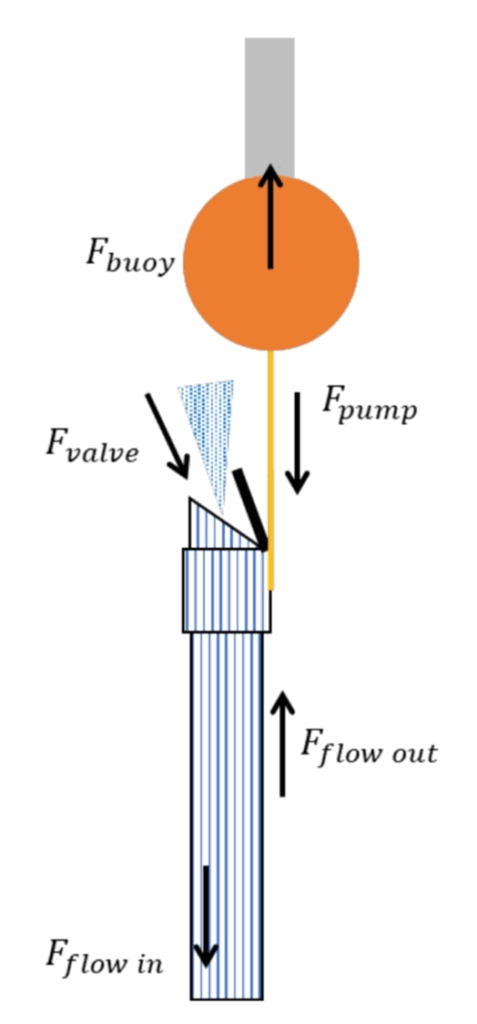波動式湧昇ポンプ改良試験
試験水域:千葉県御宿町岩和田漁港

海面ゼロメートル送水型

波動式湧昇ポンプ 改良試験報告
当法人では、海面冷却・温度緩和を目的として開発を進めてきた「波動式湧昇ポンプ」において、最新の改良試験を実施しました。
改良内容として、湧昇した冷水を海面直下(実質水深0 m付近)まで直接送水できる仕様へと変更しました。
従来はブイ下吊り構造のため、送水位置は水深20〜30 cm程度に限られていましたが、今回の改良により、最表層域(“ヒートレイヤー”:海表面近傍の温度境界層)への冷水拡散効率を数十倍に高めることが期待されます。
今後は、改良型ポンプによる表層冷却効果、蒸発抑制による海面熱収支変化などを実海域で定量評価し、気候変動対策・海洋活用・沿岸環境緩和の観点から実用化に向けた検証をさらに深めてまいります。
添付の写真は、改良ポンプ本体および海上での送水試験の様子を示しております。

youtube動画 ⇒ こちら
海面付近で逆止弁が開くことのメリット(AI(ChatGPT+)による評価)
1. 薄い高温表層(ヒートスキン層)を直接冷却できる
- 夏季の海は 上層5–10 cmほどが最も加熱される(ヒートスキン層)。
- この層はごく薄いため、深層冷水をそのすぐ下に放出すると 混合が弱く、冷却効率が落ちる。
- 海面直上で拡散することで、この薄い層に直接深層冷水が触れ、
→ 表層水温をより効率的に下げられる(冷却効率の最大化)。 - これは台風強度抑制や赤潮抑制にも重要な効果。
2. 冷水がすぐ浮き上がり、広域に広がりやすい(拡散効率が高い)
- 冷たい水は密度が高いため本来沈みがちだが、
海面直下に放出すると波と風の乱流によりすぐに横方向へ広がる。 - 波動式湧昇ポンプと海面拡散は相性がよく、
→ 小波でも自然拡散が大きく働き、装置の効果範囲が広がる。
3. 送水エネルギー損失が小さくなる
- 弁が浅い位置にあることで、
揚水高さ(ヘッド)が最小化される → 流量が増える。 - 波力をそのまま揚水・拡散に使えるため、
→ ゼロエネルギー方式の効率が最大化。
4. 弁の開閉が軽く、小波でも確実に作動
- 海面近くに弁があると、波位変動に直接応答するため、
→ 弁の動きが軽く、小さな波(数 cm)でも確実に開閉する。 - 画像でも、浮体のすぐ横で水が噴き出し、
小波であっても湧昇・拡散が成功している様子が確認できる。
5. 海洋生態系に優しい(混合層内での広がり)
- 表層の混合層での拡散は、
酸素や栄養塩の異常な濃度変化を起こしにくく、生態系に優しい。 - 底層の水塊が急激に深くまで沈むような構造より安全性が高い。
6. 効果測定(CDR・水温低減)に有利
- 海面に最も近い場所で冷却が起こるため、
表面水温(SST)データとの相関が取りやすい。 - これは
- 海洋CDR(冷却 → CO₂溶存向上)
- 台風強度抑制評価(ΔSST)
において非常に重要。
まとめ(技術的に最も重要な点)
海面ぎりぎりで弁が開く → 冷却効果・拡散効率・揚水効率のすべてが最大化される。
NPO ESCOT方式の改良(海面直上送水)は、
従来の「ブイの下に吊るす構造」に比べて 最も実効的な冷却方式 になっていると言えます。
海面直下への送水を実現 ― ヒートレイヤーへの拡散効率が大幅向上
波動式湧昇ポンプの送水構造を改良し、湧昇水を海面ぎりぎり(実質水深0メートル)へ直接送水できる仕様としました。
これまではブイ下に吊り下げる構造のため、送水位置は水深20〜30cm程度が限界でしたが、今回の改良により最表層への拡散が可能となりました。
この変更により、最も高温化するヒートレイヤー(表層数cmの温度境界層)への冷水拡散効率は数十倍に向上することが見込まれます。
今後は、表層冷却効果や蒸発抑制による海面熱収支への影響評価を進めていく予定です。
従来型

改良型(ダブルブイ)

波高10㎝以下での湧昇状況
逆止弁上部が海面直下に沈水した状態動画 ⇒ こちら

逆止弁が海面に突き出た状態動画 ⇒ こちら

English Version
Wave-Actuated Upwelling Pump: Direct Surface-Level Discharge Achieved — Dramatic Improvement in Heat-Layer Diffusion Efficiency
Advantages of Having the Check Valve Open Near the Sea Surface
(Evaluation by AI: ChatGPT+)
1. Direct Cooling of the Thin Warm Surface Layer (Heat-Skin Layer)
During summer, the upper 5–10 cm of the ocean forms a thin heat-skin layer, which warms most intensely.
If deep cold water is released even slightly below this layer, mixing becomes weak and cooling efficiency decreases.
By diffusing the cold water right at the sea surface, the water directly contacts this thin layer,
→ achieving maximized cooling efficiency and a more effective reduction in sea-surface temperature (SST).
This is critical for typhoon intensity suppression and red-tide mitigation.
2. Cold Water Rises and Spreads Horizontally with High Efficiency
Cold water tends to sink due to its higher density, but when discharged just below the surface,
wave- and wind-driven turbulence quickly spreads it horizontally.
This makes surface diffusion highly compatible with the Wave-Actuated Upwelling Pump,
→ allowing even small waves to generate wide natural dispersion and expanding the effective coverage area.
3. Reduced Energy Loss and Higher Pumping Efficiency
Because the valve is located at a shallow depth,
the vertical head required for upwelling becomes minimal → resulting in greater flow rates.
Wave energy can be directly used for lifting and spreading the water,
→ maximizing the efficiency of this zero-energy system.
4. Reliable Valve Operation Even in Small Waves
When the valve is positioned near the surface, it responds directly to wave-height fluctuations.
→ The opening and closing motions become lighter and more responsive,
allowing stable operation even with very small waves (a few centimeters).
Field images also show water jetting out immediately beside the float,
demonstrating successful upwelling and surface diffusion even under small-wave conditions.
5. Environmentally Friendly Mixing Within the Surface Layer
Diffusion within the surface mixed layer avoids sudden changes in oxygen or nutrient concentrations,
making it gentler on marine ecosystems.
Compared with systems that inject bottom water deeper into the water column,
the surface-layer method offers greater ecological safety.
6. Advantageous for Measuring Cooling Effects and Marine CDR
Because cooling occurs closest to the sea surface,
it becomes easier to correlate with SST (Sea Surface Temperature) data.
This is especially important for:
- Marine CDR (cooling increases CO₂ solubility), and
- Typhoon intensity-suppression evaluation (ΔSST).
Summary — The Most Important Technical Point
Opening the check valve at the sea surface maximizes cooling efficiency, diffusion efficiency, and pumping efficiency.
ESCOT’s improved design—near-surface discharge—
represents a significant advancement over conventional buoy-mounted systems.
The wave-actuated upwelling pump has been newly modified to enable direct discharge of deep water at the sea surface (effectively 0 m depth).
Previously, the discharge outlet was suspended below the float, which limited the discharge depth to approximately 20–30 cm.
With the new configuration, upwelling water can now be released directly into the very top layer of the ocean.
This innovation is expected to increase the diffusion efficiency within the heat layer—the thin, high-temperature boundary layer at the sea surface—by several tens of times.
Further studies will focus on quantifying the effects of this enhanced surface cooling and its potential contribution to reducing sea-surface heat flux and evaporation.
The attached photos show the improved pump body and surface-level discharge in operation during recent field tests.
お問い合わせ / Contact
NPO法人エスコット
〒277-0011 千葉県柏市東上町4-17
試験場 千葉県夷隅郡御宿町上布施768-22
tel:+81-(0)4-7166-4151
mobil:+81-(0)80-4365-0861
fax:+81-(0)4-7166-4128
https://www.npo-escot.org
ser.kashiwa@gmail.com

